Each Sunday, the bulletin at St. Isabel Parish on Sanibel offers an update on the latest efforts to recover from the devastating impacts of Hurricane Ian after the barrier island and Parish were overwhelmed by storm surge and wind damage.
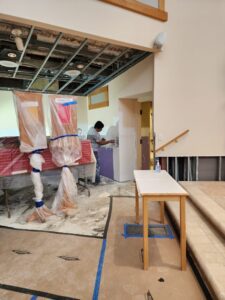
It is Pastor Father Edward Martin’s goal to ensure that the rebuild goes as quickly and smoothly as possible. Father also wants to be sure to keep parishioners appraised on what is taking place and how the Parish is moving forward through the complicated process while dealing with city code and compliance requirements, contractors and much more.
While each step in the recovery is important, it can sometimes be difficult to envision when the work will be done when delays are taking place due to supply-chain issues or other factors. When Hurricane Ian roared ashore with winds near 155 mph and a storm surge of 10 feet inundating Sanibel, the storm and severely impacted every home and business. The storm wrecked the Parish priest rectory, while saltwater intruded into the Parish church and hall. While the amount of water inside was only a few inches, the impacts were severe.

The severity was caused by the corrosive nature of saltwater, combined with a lack of access to the island for several weeks as the Sanibel Causeway was repaired. A Diocesan team accessed the island by boat to view the damage and determine what needed to be done to prevent further damage, but by the time the Causeway reopened and the island, county, state, and federal authorities determined it was safe to allow access for contractors, more damage had occurred.
This delay meant the water had time to be absorbed by the drywall, flooring, furniture, equipment doors, and pews. Once the property was accessible, contractors brought in heavy equipment and dryers to help mitigate further damage. This is the standard process for the Diocese Buildings Department for areas impacted by natural disasters.
Once detailed assessments were made of the property, it was determined that the rectory was a total loss and that the drywall and floors of the church and hall needed to be removed. Some additional drywall and ceiling work was needed because of damage to the roof and HVAC systems in both buildings. In addition, nearly the entire contents of both buildings needed to be replaced.
Father Martin said there have been great improvements made at the Parish and across the island since Hurricane Ian, but most understand why all the work isn’t completed as they deal with their own recovery.
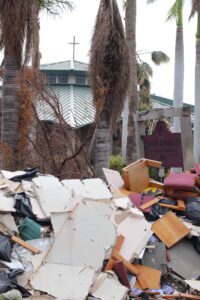
“Everyone here on Sanibel has suffered. We are going through this together,” Father Martin said. “People are buoyed by any progress, and when you hear stories of the work being done each day, that is uplifting for everyone. Here, the work to clean up the property and fix the landscaping has made a huge difference in how everyone feels. It is good to see, and we are blessed with all of the support we have received since the hurricane.”
Joe Rego, Diocese of Venice Director of Building and Construction said “by mid-April the drywall work in the church and hall were completed. Next, we are in the process of securing flooring proposals as well as waterproofing in the church.”
The main doors to the church and hall are being replaced. However, due to their size and a need to ensure they can handle any future hurricanes, getting them replaced is still a few months away.
Another example of both progress and delays are the new pews. Rego explained how the replacements were ordered three months ago, but there is up to an eight-month lead time to get them delivered and installed. The progress in the hall is further along, but the floors and kitchen are still in process, again due to unforeseen delays. Meanwhile, the HVAC systems to both buildings have been replaced, but final repairs to the roof are awaiting materials.
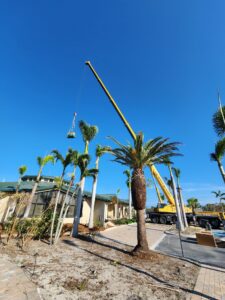
“This is not unique to St. Isabel. We are seeing these issues everywhere within the disaster zone. If we had all the supplies available, we’d be much further along in the recovery, but that just isn’t the reality,” Rego said.
The initial progress of mitigation was first evident Dec. 11, 2022, when the Holy Sacrifice of the Mass returned after an absence of 74 days.
Bishop Frank J. Dewane celebrated the first Mass after Hurricane Ian, saying he was humbled to be with the parishioners and to pray with them in the presence of the Blessed Sacrament. Bishop Dewane said that we are united in the Holy Eucharist, and prayed that the grace of the Lord gives the faithful the strength needed to rebuild from Hurricane Ian.
The Bishop stressed that as difficult as it was to see the church and Parish property with such extensive damage, “the physical church is just a building. You are the Church! What is strong is the people who make up the Church.”
During his visit, Bishop Dewane was given a tour of the property to see firsthand the extent of the damage and what was needed for a complete recovery.
Since that Sunday in December, Father Martin has been celebrating Mass as mats cover a floor which was stripped bare to the concrete base. With the pews removed, folding chairs are in their place.
“We were blessed that the main sanctuary, where the altar and tabernacle are located, was untouched by the hurricane. What we have left is a bit primitive, but it works,” Father said.
When the work in the hall is completed, the Mass will be temporarily transferred to help facilitate the reconstruction of the church.
The repair work will take time to be completed, as the devastation is unprecedented, not only to the people of Sanibel, but to the entire region which received extreme damage from Hurricane Ian while displacing thousands.
If you would like to support the rebuilding effort for St. Isabel Parish, please visit https://www.saintisabel.org/ or go to https://dioceseofvenice.org/hurricaneian/.





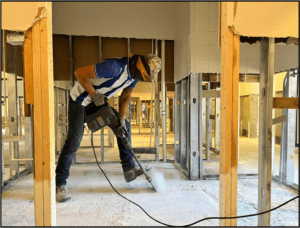 OLPH Director, Father Mark Yavarone, Oblate of the Virgin Mary, first inspected the property by kayak on Sept. 29, 2022, the day after the hurricane. At that time, the Myakka River waters had risen to cover the entire property and were as high as they had ever been since OLPH was founded in 1988. Father noted at the time he was shocked to see the water so high, unaware that the menacing river was not done rising.
OLPH Director, Father Mark Yavarone, Oblate of the Virgin Mary, first inspected the property by kayak on Sept. 29, 2022, the day after the hurricane. At that time, the Myakka River waters had risen to cover the entire property and were as high as they had ever been since OLPH was founded in 1988. Father noted at the time he was shocked to see the water so high, unaware that the menacing river was not done rising.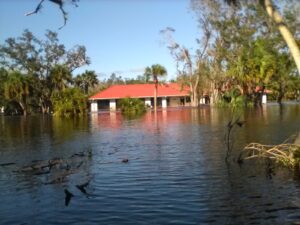
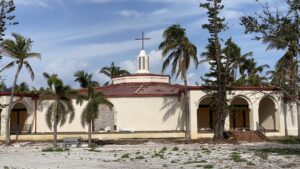
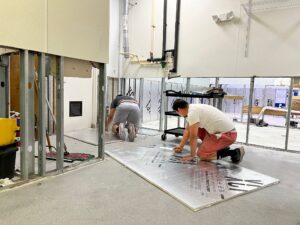

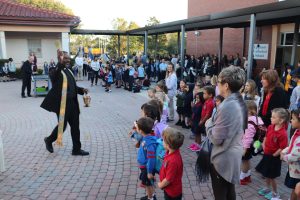 “What a wonderful day,” Principal Nicole Loseto proclaimed. “When the hurricane struck everyone rallied together to salvage what we could to relocate classrooms all over the campus in just two days. It was a challenge to move everyone to a new location and it was seamless and beautiful… Now everyone came together to get us back into our main building. Thank you, everyone!”
“What a wonderful day,” Principal Nicole Loseto proclaimed. “When the hurricane struck everyone rallied together to salvage what we could to relocate classrooms all over the campus in just two days. It was a challenge to move everyone to a new location and it was seamless and beautiful… Now everyone came together to get us back into our main building. Thank you, everyone!”
 Only the pre-kindergarten students were not displaced by Hurricane Ian. The disruptions were extreme as kindergartners were housed in the library; first and second grades were placed in the cafeteria with a divider; fourth and fifth graders were in the Parish Hall; and middle schoolers were split between the Soy Hall and two gymnasium locker rooms.
Only the pre-kindergarten students were not displaced by Hurricane Ian. The disruptions were extreme as kindergartners were housed in the library; first and second grades were placed in the cafeteria with a divider; fourth and fifth graders were in the Parish Hall; and middle schoolers were split between the Soy Hall and two gymnasium locker rooms.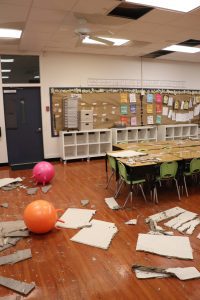 She also gave a shout out to the many people who helped support the recovery effort through financial support which helped ease the burden on the school.
She also gave a shout out to the many people who helped support the recovery effort through financial support which helped ease the burden on the school.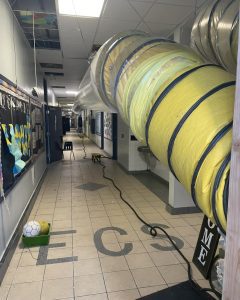
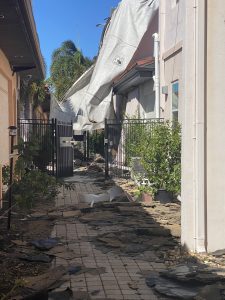 Ahead of the reopening, a team of faculty staff and parents moved all of the desks and other educational items from their temporary rooms to the main building. The upper grades were allowed in the building on Jan. 6, the 100th day since Hurricane Ian struck Venice.
Ahead of the reopening, a team of faculty staff and parents moved all of the desks and other educational items from their temporary rooms to the main building. The upper grades were allowed in the building on Jan. 6, the 100th day since Hurricane Ian struck Venice.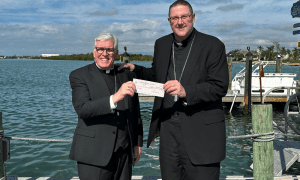 Bishop Parkes met with Bishop Frank J. Dewane on Dec. 21, 2022, in Venice to personally present the check for $250,000. These funds were the result of a special collection following the hurricane.
Bishop Parkes met with Bishop Frank J. Dewane on Dec. 21, 2022, in Venice to personally present the check for $250,000. These funds were the result of a special collection following the hurricane. In a Sept. 30 letter to all Parishes in the Diocese of St. Petersburg, Bishop Parkes wrote: “Our hearts are moved with compassion for all those who have suffered damage and destruction due to Hurricane Ian, especially our brothers and sisters in the Diocese of Venice.”
In a Sept. 30 letter to all Parishes in the Diocese of St. Petersburg, Bishop Parkes wrote: “Our hearts are moved with compassion for all those who have suffered damage and destruction due to Hurricane Ian, especially our brothers and sisters in the Diocese of Venice.” Bishop Frank J. Dewane celebrated the Mass at 10 a.m., Dec. 11, 2022, expressing his prayers that all continue to recover with the grace of the Lord giving them strength. The Bishop added that since the hurricane passed, “Sanibel, and all in Southwest Florida, have been in my prayers. The church is a building, you are the Church, all of you. What is strong is the people who make up the Church.”
Bishop Frank J. Dewane celebrated the Mass at 10 a.m., Dec. 11, 2022, expressing his prayers that all continue to recover with the grace of the Lord giving them strength. The Bishop added that since the hurricane passed, “Sanibel, and all in Southwest Florida, have been in my prayers. The church is a building, you are the Church, all of you. What is strong is the people who make up the Church.” Bishop Dewane cited the “desert experience” which is a theme of the readings for the day, recounting saints and prophets who lived in parched lands, with everyday things stripped away. This “desert experience” is being lived daily at the Parish and throughout the island as every building has some form of damage and is in different stages of recovery and/or repair while the landscape is only now slowly returning to its glorious splendor. Simple conveniences are sparse with little open and access to the barrier island still restricted.
Bishop Dewane cited the “desert experience” which is a theme of the readings for the day, recounting saints and prophets who lived in parched lands, with everyday things stripped away. This “desert experience” is being lived daily at the Parish and throughout the island as every building has some form of damage and is in different stages of recovery and/or repair while the landscape is only now slowly returning to its glorious splendor. Simple conveniences are sparse with little open and access to the barrier island still restricted. The smiles on the faces were genuine as many were relieved to have the important faith component as part of the Sanibel recovery.
The smiles on the faces were genuine as many were relieved to have the important faith component as part of the Sanibel recovery. Ian struck on Sept. 28, 2022, with winds up to 155 mph and storm surge measured at 15 feet swept across Sanibel and Fort Myers Beach. In all, the wide impacts of Ian caused damage at 30 Parishes and 10 Catholic schools, as well as at many other Diocesan properties.
Ian struck on Sept. 28, 2022, with winds up to 155 mph and storm surge measured at 15 feet swept across Sanibel and Fort Myers Beach. In all, the wide impacts of Ian caused damage at 30 Parishes and 10 Catholic schools, as well as at many other Diocesan properties.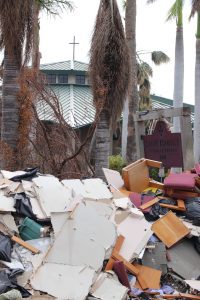 The approach to the Parish on Sanibel-Captiva Road revealed a pile of debris at least six feet high and approximately 75 yards long, obstructing the street view of the Parish property. This pile of debris included the contents of the hall and church, including flooring, drywall, ceiling tiles, furniture, and other built-in materials which were all beyond salvage. In addition, there was the debris that was scattered across the property by the surge and wind, such as trees, branches, pieces ripped from the Parish buildings, as well as various detritus scattered by the wind and water from nearby properties.
The approach to the Parish on Sanibel-Captiva Road revealed a pile of debris at least six feet high and approximately 75 yards long, obstructing the street view of the Parish property. This pile of debris included the contents of the hall and church, including flooring, drywall, ceiling tiles, furniture, and other built-in materials which were all beyond salvage. In addition, there was the debris that was scattered across the property by the surge and wind, such as trees, branches, pieces ripped from the Parish buildings, as well as various detritus scattered by the wind and water from nearby properties.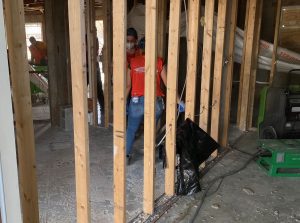 The cleanup at Ascension Parish and the Poor Clare monastery on Fort Myers Beach started sooner but the destruction there was more complete. Contractors have been on the property since two weeks after Ian’s landfall dealing with what was left over after the storm surge blasted through the church, hall, rectory, and monastery.
The cleanup at Ascension Parish and the Poor Clare monastery on Fort Myers Beach started sooner but the destruction there was more complete. Contractors have been on the property since two weeks after Ian’s landfall dealing with what was left over after the storm surge blasted through the church, hall, rectory, and monastery. In each building, the work crews also cut out the drywall and floors. Fortunately, the walls of the church and monastery were made of concrete, meaning no structural damage occurred. Part of securing the property from any further damage included putting plywood over each of the blown-out windows and doors as air blowers were helping with the final drying out process.
In each building, the work crews also cut out the drywall and floors. Fortunately, the walls of the church and monastery were made of concrete, meaning no structural damage occurred. Part of securing the property from any further damage included putting plywood over each of the blown-out windows and doors as air blowers were helping with the final drying out process.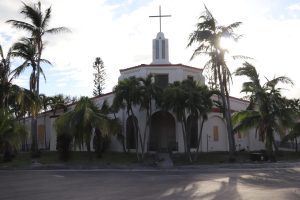 While it is hoped that reconstruction work can begin immediately, there is a shortage of workers and key supplies, such as drywall, plywood, flooring, and roofing materials, throughout the disaster zone.
While it is hoped that reconstruction work can begin immediately, there is a shortage of workers and key supplies, such as drywall, plywood, flooring, and roofing materials, throughout the disaster zone.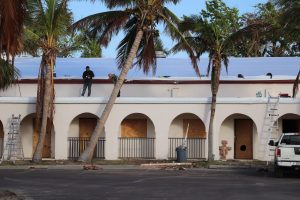 Incarnation Parish and Catholic school in Sarasota both had damage and water intrusion during Ian and the winds from Nicole penetrated the tarps. Parish and school staff reported new water intrusion and teams were quick to come out to mitigate any further damage.
Incarnation Parish and Catholic school in Sarasota both had damage and water intrusion during Ian and the winds from Nicole penetrated the tarps. Parish and school staff reported new water intrusion and teams were quick to come out to mitigate any further damage.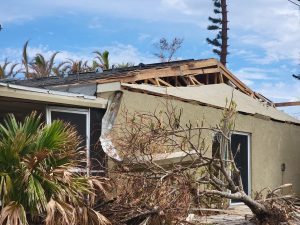 St. Isabel Parish, which is located on a high point toward the east side of the island, had major damage. The church and parish hall are intact but had extensive water damage. Unfortunately, the Parish rectory was not so lucky. There is extensive damage with holes in the roof, as well as impacts from the surge which filled the entire building.
St. Isabel Parish, which is located on a high point toward the east side of the island, had major damage. The church and parish hall are intact but had extensive water damage. Unfortunately, the Parish rectory was not so lucky. There is extensive damage with holes in the roof, as well as impacts from the surge which filled the entire building.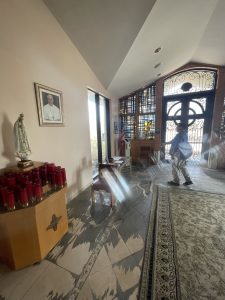 Father Martin said he expects to either set up a tent outside for Mass in the coming weeks, or that the hall can be repaired quickly to accommodate the Liturgy.
Father Martin said he expects to either set up a tent outside for Mass in the coming weeks, or that the hall can be repaired quickly to accommodate the Liturgy. One of the reasons the damage wasn’t worse was attributed to the fact that the church had a major renovation and upgrade after Hurricane Charley ripped the roof off in 2004. A similar upgrade took place in the Parish Hall in 2016. All this held back the worst of the winds and most of the water.
One of the reasons the damage wasn’t worse was attributed to the fact that the church had a major renovation and upgrade after Hurricane Charley ripped the roof off in 2004. A similar upgrade took place in the Parish Hall in 2016. All this held back the worst of the winds and most of the water.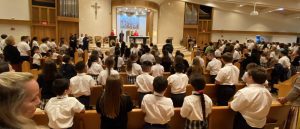 The coordination necessary to get each school opened in a safe and timely manner was the work of countless staff and volunteers who banded together, focused on a singular goal. The final four schools to reopen were in the hardest hit areas of Lee and Charlotte County – St. Charles Borromeo Catholic School in Port Charlotte, St. Andrew Catholic School in Cape Coral, and St. Francis Xavier Catholic School and Bishop Verot Catholic High School, both in Fort Myers.
The coordination necessary to get each school opened in a safe and timely manner was the work of countless staff and volunteers who banded together, focused on a singular goal. The final four schools to reopen were in the hardest hit areas of Lee and Charlotte County – St. Charles Borromeo Catholic School in Port Charlotte, St. Andrew Catholic School in Cape Coral, and St. Francis Xavier Catholic School and Bishop Verot Catholic High School, both in Fort Myers.
 At Bishop Verot Catholic High School, where awnings were torn away, portable classrooms damaged and bleachers twisted like pretzels, the return to school on Oct. 17 was met with joy and sorrow as many students and faculty had severe damage to homes, some losing everything to Ian’s wrath.
At Bishop Verot Catholic High School, where awnings were torn away, portable classrooms damaged and bleachers twisted like pretzels, the return to school on Oct. 17 was met with joy and sorrow as many students and faculty had severe damage to homes, some losing everything to Ian’s wrath.
 As impressive as it has been to get the schools back open so quickly, Bishop Dewane and Father Belmonte have also said the schools are reflecting their Christian core by their continued outreach into the community, helping not only their own school communities but others who have been in need.
As impressive as it has been to get the schools back open so quickly, Bishop Dewane and Father Belmonte have also said the schools are reflecting their Christian core by their continued outreach into the community, helping not only their own school communities but others who have been in need. Students from St. Ann Catholic School in Naples have been very busy. First, they held a food and emergency relief drive, which was combined with an effort by St. John the Evangelist Parish to benefit the St. Vincent de Paul Society Naples food pantry. The school then collected thousands in gift cards to give to needy families. Finally, the students sent handmade “Thank You” notes to local first responders, including the Naples Police Department, in gratitude for their work in protecting the community during and after the hurricane.
Students from St. Ann Catholic School in Naples have been very busy. First, they held a food and emergency relief drive, which was combined with an effort by St. John the Evangelist Parish to benefit the St. Vincent de Paul Society Naples food pantry. The school then collected thousands in gift cards to give to needy families. Finally, the students sent handmade “Thank You” notes to local first responders, including the Naples Police Department, in gratitude for their work in protecting the community during and after the hurricane. Student and parents from St. Martha Catholic School in Sarasota used a day off from school on Oct. 17 to volunteer at All Faiths Food Bank, the regional supplier for food pantries in Sarasota and DeSoto counties. The volunteers filled 160 boxes of food and 1,500 backpacks for local families and students.
Student and parents from St. Martha Catholic School in Sarasota used a day off from school on Oct. 17 to volunteer at All Faiths Food Bank, the regional supplier for food pantries in Sarasota and DeSoto counties. The volunteers filled 160 boxes of food and 1,500 backpacks for local families and students.